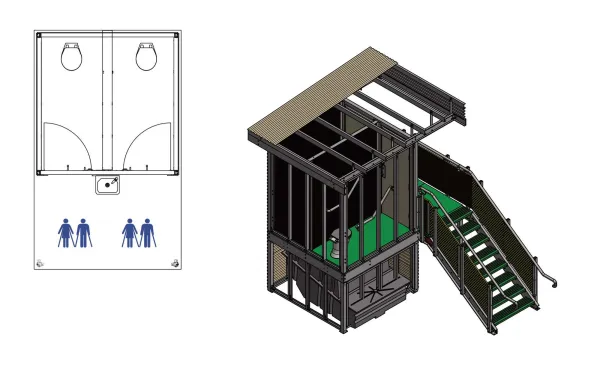Ambulant and accessible toilets are not the same thing. An accessible WC is a larger room (for wheelchair users and others who need turning/transfer space). An ambulant WC is a standard-sized cubicle fitted with supports and clearances for people who are mobile but need assistance (crutches, limited balance, temporary injuries). In New Zealand, accessible rooms are guided by NZS 4121:2001 within the Building Code framework; for ambulant cubicles, many NZ projects adopt dimensional details from AS 1428.1:2021 as good practice where NZS 4121 is silent—always confirm with your Building Consent Authority (BCA).
The NZ compliance framework (what applies)
- NZ Building Code G1 Personal Hygiene sets the performance requirements for sanitary fixtures and references accessible provisions (with NZS 4121:2001 cited in the Compliance Document).
- NZS 4121:2001 – Design for access and mobility is the primary NZ reference for accessible layouts, routes, fixtures and signage.
- Ambulant cubicles: this guide uses AS 1428.1:2021 for sizes/rail layouts by agreement with the BCA, since NZS 4121 focuses on accessible rooms rather than ambulant compartments.
Typical ambulant WC requirements used in NZ (from AS 1428.1:2021)
Treat the following as typical design targets used in New Zealand projects; check your consent conditions and any BCA clarifications:
- Cubicle width: ~900–920 mm; door clear opening: ≥ 700 mm.
- Clearances: maintain ~900 mm clear space where required, including between pan and door swing; place the basin outside the required circulation zone.
- Grab rails: both sides, Ø 30–40 mm, rounded ends; fixed to resist the loads prescribed in AS 1428.1:2021.
- Pan & seat: pan projection ~610–660 mm from back wall; seat height ~460–480 mm.
- Hardware & accessories: privacy latch with lever action; coat hook ~1350–1500 mm AFFL; paper holder within reach; signage indicating left- or right-hand rail arrangement; clear in-use indicator and emergency access features (e.g., lift-off hinges) per the 2021 edition.
Note: AS 1428.1:2021 includes updates from earlier editions (e.g., some rail dimensions/placements). If your BCA specifies a different edition, document to that requirement; otherwise, use 2021 as the reference.
Frequent consent pitfalls (and how to avoid them)
- Substitution error: providing an ambulant cubicle instead of the required accessible WC under G1/NZS 4121. Many facilities need both.
- Pinched clearances: door widths or circulation spaces reduced by basins or dispensers—keep required zones clear.
- Signage & orientation: missing tactile/Braille or incorrect left/right rail indication at the door; ensure routes and signs align with NZ guidance.
Practical NZ design tips
- Use non-slip, drain-through FRP ramps to maintain safe entry in wet conditions and keep gradients compliant.
- Apply CPTED basics: clear sightlines, even lighting, and obvious entries improve safety and usability.
- Standardise fixtures (rails, latches, dispensers) across sites to simplify maintenance and spares.
Need a code-aligned accessible room plus an ambulant cubicle in the same block?
We supply drawings and specifications aligned to G1, NZS 4121:2001 (accessible WC) and detail AS 1428.1:2021 provisions for ambulant cubicles as agreed with your BCA—along with ramps, signage, and compliant hardware. Contact WCTNZ® for design and pricing.
